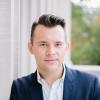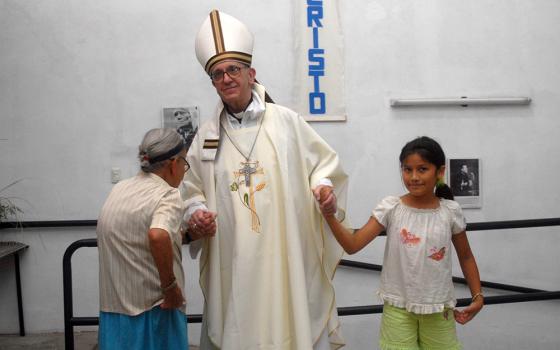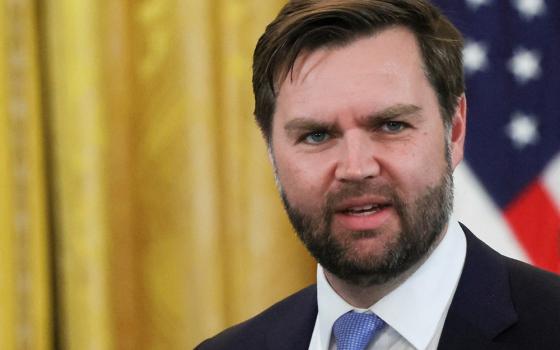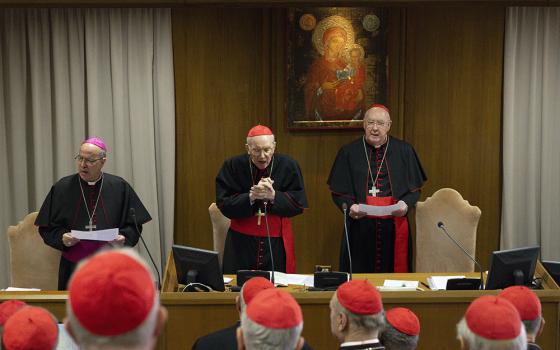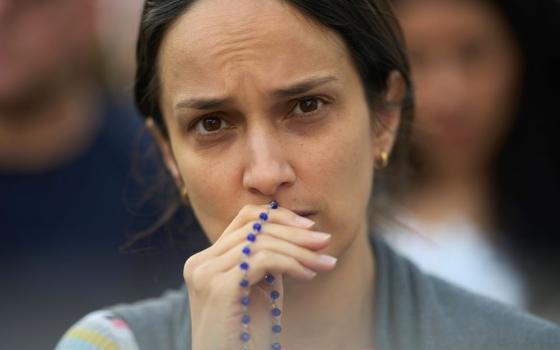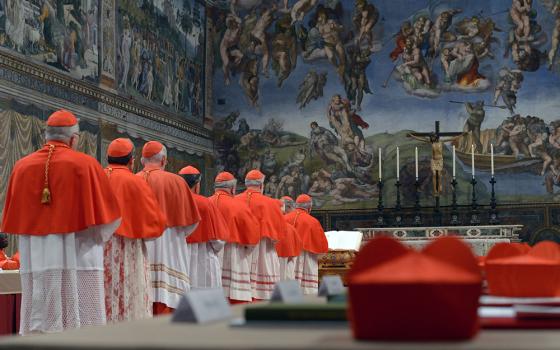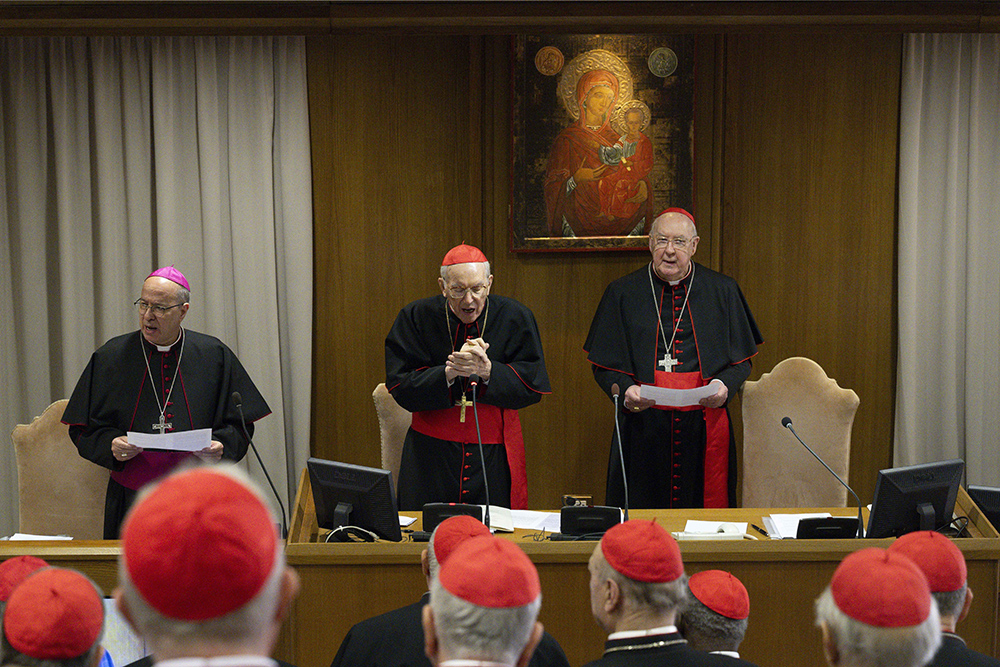
Cardinal Giovanni Battista Re, dean of the College of Cardinals, center, leads cardinals in prayer during their first general congregation April 22, 2025, in the Vatican Synod Hall. To Cardinal Re's left is U.S. Cardinal Kevin Farrell, chamberlain of the Holy Roman Church, and to the left is Archbishop Ilson Montanari, secretary of the College of Cardinals. (CNS/Vatican Media)
The day after Pope Francis died, 60 cardinals met inside the Vatican on April 22 and swore an oath, beginning secretive deliberations about the late pontiff's final arrangements — and setting the stage for who will succeed him.
By the time of the cardinals' third meeting on April 25, a day before Francis' funeral, that number had more than doubled to 149 cardinals for these almost daily gatherings known as general congregations ahead of the conclave, the assembly of cardinals to elect a new pope.
The general congregations are equally as important as the conclave, and possibly more so. Twelve years ago, according to the lore around Pope Francis, a speech Argentina's Cardinal Jorge Mario Bergolio gave at a congregation clinched his election.
"The general congregations offer a forum that's more open and discussion-oriented than the actual conclave," said veteran Vatican journalist John Thavis in an interview with the National Catholic Reporter. "This allows cardinals to exchange views, identify candidates and, to some degree, lobby for their favorites."
Advertisement
The cardinals already have a lot to say. To date there have been nearly 70 individual speeches, according to the Vatican press office, as the men look ahead to the all-important votes to decide who will next lead the world's 1.4 billion Catholics.
Only the 135 cardinals who are under the age of 80 can enter the Sistine Chapel to participate in the conclave. However, the general congregations are open to all 252 men in the College of Cardinals.
In short, it's a time to reassess the church's pastoral priorities and also audition certain personalities to see if they might be right for the top job.
The congregations are "an occasion when the careful discernment of character and competence of potential papabili is more subtle than partisan," said Michael Higgins, author of The Jesuit Disruptor: A Personal Portrait of Pope Francis.
"They are a stage on which the disparate and diverse members of an ever-enlarging College of Cardinals get to fraternize and familiarize in unthreatening ways," Higgins said.
In addition to the formal speeches, known formally as interventions, there are the coffee breaks and walks to and from the Vatican. These planned and impromptu encounters are critically important because it is where the cardinals get to know each other.

U.S. Cardinal Kevin Farrell, chamberlain of the Holy Roman Church, speaks with Archbishop Ilson Montanari, secretary of the College of Cardinals, right, and Cardinal Pietro Parolin, Vatican secretary of state under Pope Francis, after the first general congregation of the College of Cardinals in the Vatican Synod Hall April 22, 2025. (CNS/Vatican Media)
The informal get-togethers are important because many of the cardinals have spent little time together and this is when they ask questions of each other — and themselves — as they contemplate what and who will take the seat of St. Peter.
"For 80% of the conclave voters, this is an entirely new experience," Thavis said. "They need time to take in ideas and take the measure of potential candidates."
Thavis said this is especially true this time. "Pope Francis made a point of creating cardinals from distant places, and they are generally not familiar figures," Thavis said.
During the 2013 conclave, one of the major fault lines among the cardinals was whether reform was urgently needed in the Roman Curia, the church's central government. After years of bad headlines, from abuse to the financial scandal, there was a growing appetite for an outsider to clean up the Curia.
While cardinals are barred from campaigning for the job, they are allowed to speak freely. And in 2013, when Argentina's Cardinal Bergolio did that, he inadvertently got himself elected to the top job, which by all accounts he was by no means seeking.

Cardinals Timothy Radcliffe and Michael Czerny walk through the Vatican on their way to the first general congregation of the College of Cardinals April 22, 2025, in the Vatican Synod Hall. (CNS/Vatican Media)
"Pope Francis made a point of creating cardinals from distant places, and they are generally not familiar figures."
— John Thavis
"When the church does not come out of herself to evangelize, she becomes self-referential and then gets sick," he told the other cardinals, according to his notes he later gave to another cardinal from Latin America.
"In Revelation, Jesus says that he is at the door and knocks," Bergoglio told his fellow cardinals. "Obviously, the text refers to his knocking from the outside in order to enter but I think about the times in which Jesus knocks from within so that we will let him come out."
"The self-referential church keeps Jesus Christ within herself and does not let him out," he said.
It was only a four-minute speech.
But, as Thavis recalled, "his words impressed many cardinals and clinched his ascent to the papacy."
Bergoglio, said the papal biographer Higgins, "was the ideal outsider they could trust. He offered the electors a way out of the moral and mismanagement malaise on the Tiber."
Twelve years later, as the cardinals return to these general congregations ahead of a conclave, which is likely to begin by May 6, history reminds us that what will be happening behind the Vatican's closed doors, could open up new horizons for tomorrow's Catholic Church.
The National Catholic Reporter's Rome Bureau is made possible in part by the generosity of Joan and Bob McGrath.
